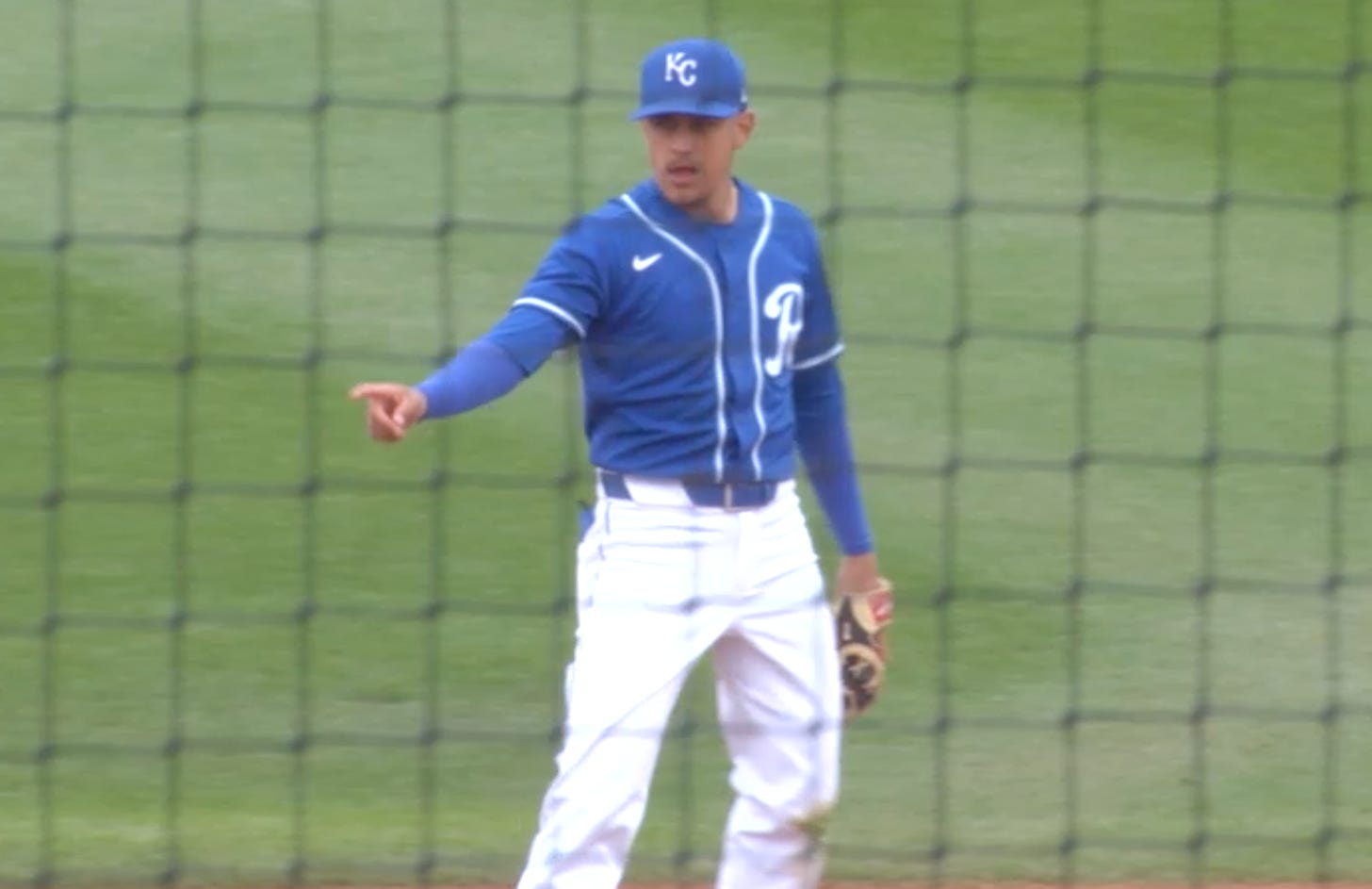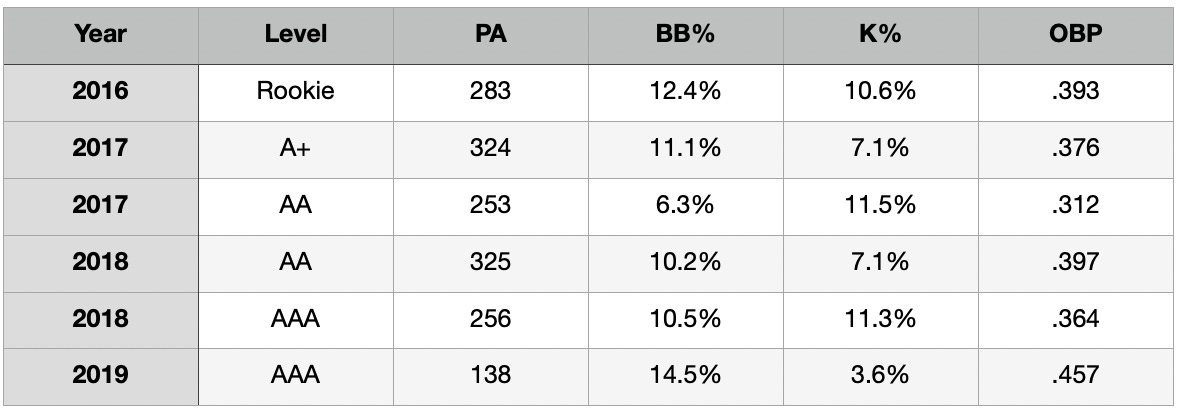Royals option Nicky Lopez
With the team looking for maximum wins, a difficult spring couldn't be ignored.
On Sunday, the Royals made the obvious official: They optioned Nicky Lopez to Triple-A. He will not make the Royals’ squad for Opening Day.
If you’ve been reading this newsletter for any length of time, you know through the various roster projections this spring that this move wasn’t anticipated when the Royals reported to camp in Surprise last month. Lopez certainly scuffled with the bat in 2020, hitting .201/.286/.266 in 192 PAs, but he wasn’t the only player who had a subpar offensive season in 2020, what with the shortened schedule and all. Although he did this while playing premium defense at second base.
But his 2020 season did mirror his 2019 in many ways, where Lopez hit .204/.276/.325. In both seasons his strikeout to walk ratio was about 3:1.
Lest we forget, Lopez’s offensive profile was built around on-base percentage. Through the course of his minor league career, he had one stretch immediately after he was promoted to Double-A where he scuffled. For the rest of the time, his walk rate was generally slightly better than his strikeout rate and his OBP was north of .360.
While the struggles Lopez faced in his first go-around in Double-A would be troubling, he assuaged any concerns by repeating the level and returning to his modus operandi in the batter’s box. Perhaps he was just a hitter who took a while to get acclimated to his new digs after a promotion. He wouldn’t be the first hitter to need a little more time to make adjustments while moving upward in the organization.
Or maybe not. Those Triple-A rates were impressive from the jump. And like his second go-round in Double-A, his follow-up in Omaha was even better. His call-up in 2019 was deserved.
It really is all about the on-base percentage. Damn the power. Lopez in the past has tried to bulk up to put a little more oomph behind the ball when he connects. But that’s really not his game. And it’s not ever going to be his game. The most extra-base hits Lopez ever collected in a single year prior to making the majors was in 2018 when he combined for 14 doubles and nine home runs split between Double and Triple-A. Upon arriving at The K in 2019, he took advantage of the spacious yard to club 22 doubles.
Hitting at the bottom of the order, Lopez’s job is to get on base and try to extend any rallies (or maybe start a few new ones as the lineup flips over.) He’s shown he can do this throughout his minor league career, but he has to rediscover the patience he showed back then.
Here are the same rates as shown in the table above, but for his major league career.
He was able to double his walk rate from 2019 (that’s great!), but it came at the expense of his strikeout rate jumping to above 20 percent (that’s awful!). That’s a hitter who is lost and overmatched at the plate.
Again, statistics for 2020 will always come with a caveat. Between the time off starting in mid-March, the summer camps which was an abbreviated attempt to prepare for a season that felt precarious from the jump, we saw several players perform under their usual levels. Lopez, however, didn’t have the luxury of a major league track record to fall back upon to explain away sketchy numbers like a strikeout rate above 20 percent. So when Lopez whiffed 13 times in 39 spring training PAs (a 33% whiff rate) against just five walks (a 13%) walk rate, it looked like not much had changed from the previous year. Naturally, you can take spring training stats with a grain of salt, but in some cases, they can’t be ignored.
Lopez didn’t need to have a great spring, but he couldn’t afford to have one as dreadful as he did. And it cost him his job.
The defense will always be there. In 2019, Lopez was worth one Defensive Run Saved according to The Fielding Bible. That’s not necessarily great, but it’s solid. It’s average to the point where he made a handful more plays graded as “great” as opposed to making a play labeled a “defensive miscue.” He graded well on his range, particularly to his right.
In 2020, he took it up several notches to become one of the premier defenders of the keystone. In the shortened season, his nine Defensive Runs Saved led all second basemen and his “great” fielding plays doubled his “miscues.” His range was still strong to his right and was even better to his left. He was a finalist for the AL Gold Glove at second, and deservedly so.
But there always needs to be a balance on the diamond. And the defensive excellence from Lopez could not offset the offensive liability he has become.
Lopez needs to hit the reset button and get back to what made him successful in the minor leagues—reaching base by any means. But the Royals are set on competing in 2021 and that means they can’t afford to give anyone—Lopez included—time to figure things out at the major league level. The desire to win now means the club has to ride with the nine it feels gives them the best chance to compete. Right now that nine does not include Lopez. And based on how things go for the team the first couple months of the season, it’s conceivable that we won’t see him again at The K this year.
The Royals will almost certainly ride with Whit Merrifield at second, but the offseason acquisition of Hanser Alberto gives them options. Throw in the additional versatility of Hunter Dozier to move between the infield and outfield and there are myriad options for Mike Matheny’s lineup card. And this almost certainly means Kyle Isbel will be making the team.
It’s interesting, isn’t it? A player like Isbel arrived in camp probably not even expecting to win a spot with the big club. While Lopez likely figured he was a lock. And now here we are.
Nobody said playing in the majors was easy. And sometimes, getting back to that level can be just as difficult.







This is a great take. Thanks for going into this. I agree ST numbers should be taken with a grain of salt, but as you said, bad numbers, especially for a player without much MLB history to lean back on, can definitely sink a player, as it did with Lopez. The changes in K rate in 2020 and this Spring have been alarming, and I do think playing everyday in Omaha and trying to figure it out is the best course of action. The glove is ready, and we know he can be a backup infielder, but he needs to find that ability to get on base again that made him so valuable. Hopefully so work in extended Spring Training and in Omaha, with the pressure now off of him, can help him reconnect with what made him successful prior to 2019.